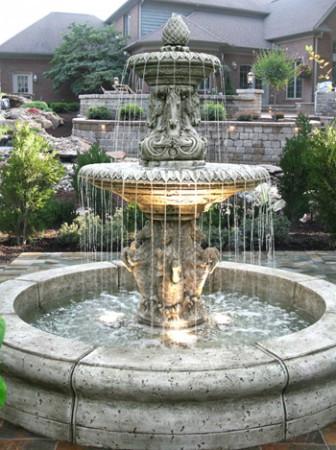Winterizing Your Fountain
Winterizing your outdoor fountain is a fabulous way to extend the life of your water feature. You will need to winterize your water fountain if you live in a region that experiences freezing temperatures during the winter months. Freezing water must expand on a molecular level and even the best-built cast stone water fountain can be cracked when forced to deal with this unchangeable law of nature. You can also cause a significant amount of damage to your pump and lines if you decide to not winterize your outdoor water fountain.
Winterizing Outdoor Water Fountains -Helpful Tips
While there are expensive chemicals you can use on your outdoor fountain to help winterize it, this guide is going to show the most cost effective ways to keep your water feature safe. You can save your money by following the tips below and keep your water fountain in tip top condition for years to come.
- Remove the Water
- Move Your Water Fountain Indoors
- Service Your Pump
- Cover Large Water Fountains
- Use Absorbent Materials
Let’s take a moment to examine each of these steps and see how they can help in winterizing outdoor water fountains.
Remove the Water
The first step to any winterizing strategy is to remove all of the water from your outdoor water fountain. You will not be able to winterize your fountain if you do not remove all of the water from it. This includes the lines and pumps as well. Your fountain needs to be dry before the temperatures begin to drop if you want to guarantee you don't have cracking caused from freezing water. Your lines will need to be double checked as water can often go unnoticed in these locations. It is critically important that you removed all the water out of your unit before the freezing temperatures hit your area.
Move Your Water Fountain Indoors
You may be able to move your outdoor water fountain depending on its size. Larger water fountains may be impossible to move without the assistance of machinery but tiered fountains can be disassembled into smaller pieces that can help you save storage space. Moving your water feature into a garage, barn, or shed is ideal because it will eliminate direct exposure to the harsh winter winds and moisture. This can keep your outdoor fountain looking and running great.
Service Your Pump
In many instances, you may be able to remove your outdoor water fountains pump. This is an excellent option that can allow you to clean your pump thoroughly to ensure it will continue to operate smoothly. Cleaning a water pump can help to reduce algae and other debris from creating a blockage and burning your pump's motor out. You should store your pump indoors once it has been completely cleaned and all water has been removed. Outdoor fountain pumps are expensive and the number one reason they fail is a lack of maintenance. Take this time to get your motor maintenance and you will be enjoying the relaxing sounds and sights of your water feature for many years to come.

Cover Large Water Fountains
If you own a large water fountain that is unable to be moved, you will need to consider other options to winterize your unit. A fountain cover is going to be the best option for larger water features. A high-quality outdoor fountain cover will offer excellent protection from moisture and other harmful contaminants. Most fountain covers will incorporate some form of draw string to lock your cover onto your fountain securely. Fountain covers come in a variety of sizes, so be sure to get an accurate measurement of the size you need.
Use Absorbent Materials
If you are unable to move or cover your outdoor fountain, you can still drain it and fill the basin with moisture absorbent materials such as blankets. The intention here is to provide the moisture a place to go beside inside your fountain. This is the last resort and if water gets inside your lines you may still have some cracking occur. You will still want to remove your pump with this strategy as the smallest amount of moisture can cause damage to a fountain pump.
Conclusion
Outdoor fountains are an excellent way to add some life to your yard or garden. Birds love to sing and wash in the basin and the sound of running water is therapeutic. Unfortunately, outdoor fountains are not cheap and protecting your investment should be priority number one. Sadly, the main reason why water fountains go bad is a lack of maintenance. This is completely avoidable by following the steps in this winterization guide. Don't leave your investment out in the cold to freeze and you are going to be enjoying the soothing trickle of a water feature for many years to come.
